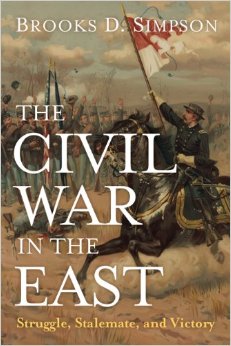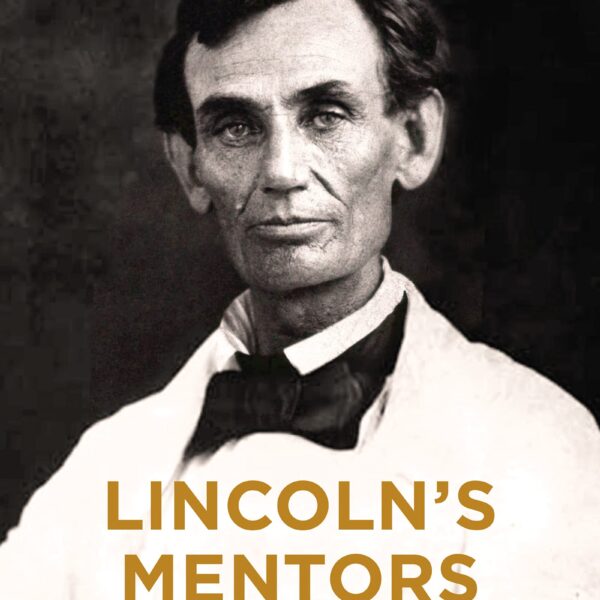The Civil War in the East: Struggle, Stalemate, and Victory by Brooks D. Simpson. Potomac Books, 2013. Paper, ISBN: 1612346286. $19.95.
 Scholars, students, and teachers should hail the appearance of Brooks D. Simpson’s sure-handed volume, The Civil War in the East, in a new paperback edition (the book appeared in hardback, published by Praeger, in 2011). Paradoxically, Simpson argues for the decisiveness of the Eastern Theater to the Union’s triumph by demonstrating that a strategic stalemate prevailed there for nearly the entire span of the war. Simpson aims to provide a holistic analysis of military operations, taking into account politics, public opinion, geography, and logistics—and he succeeds. The book is clear and informative—fully accessible to non-specialists—and yet intervenes in a number of ongoing scholarly debates, delivering a bracing dose of insight and common sense in a congenial tone.
Scholars, students, and teachers should hail the appearance of Brooks D. Simpson’s sure-handed volume, The Civil War in the East, in a new paperback edition (the book appeared in hardback, published by Praeger, in 2011). Paradoxically, Simpson argues for the decisiveness of the Eastern Theater to the Union’s triumph by demonstrating that a strategic stalemate prevailed there for nearly the entire span of the war. Simpson aims to provide a holistic analysis of military operations, taking into account politics, public opinion, geography, and logistics—and he succeeds. The book is clear and informative—fully accessible to non-specialists—and yet intervenes in a number of ongoing scholarly debates, delivering a bracing dose of insight and common sense in a congenial tone.
The Civil War in the East offers a chronological narrative of campaigns and battles, moving from First Bull Run to Appomattox. The narrative traces the process by which the Eastern Theater became synonymous with Virginia, Maryland, and Pennsylvania—a process dictated not only by the location of the two rival capitals, but also by the abandonment and failure of Union initiatives along the Carolina coasts. Simpson is expert in defining the challenges that characterized each phase of the war. His narrative is linked together by certain key themes: the role of rivalries within the Union and Confederate high commands in informing decision-making; the toll of missed opportunities; the difficulty of coordinating military movements; the trial-and-error quality of much of the leadership exercised on either side, even by experienced commanders; and the elusiveness of decisive victories.
Simpson asks readers to reconsider some of the truisms that linger on in Civil War scholarship. Were Fredericksburg and Chancellorsville Lee’s “masterpieces”? Both of these Confederate victories, Simpson notes, are largely attributable to how poorly-led Union forces were—and neither victory, a frustrated Lee himself conceded, broke the strategic stalemate in the east. Did Longstreet’s hesitancy lose Gettysburg for the Confederates? No, Simpson explains: his attack on July 2 was “one of the most powerful assaults ever unleashed during the war” (83). Lee’s own mistakes—particularly his miscalculation that the Union would once again be poorly led—were the greater factors in the battle’s outcome. Was Gettysburg the “turning point” of the war? Most assuredly, no: the late summer and fall of 1863 found the Union and Confederacy yet mired in strategic stalemate. It took Grant’s assumption of command in the East to break the deadlock. It was Grant, Simpson argues, who rejected the “either-or” mentality that had plagued strategic thinking—the debates, for example, over whether the Union should focus on capturing Richmond or destroying Lee’s army, on overland or waterborne offensives, on the Eastern Theater or the Western Theater. Grant’s winning strategy combined all of these options—he brought to bear a skill at executing initiatives (and at working with both his superiors and subordinates) that no other Union commander in the East could rightfully boast of.
Given what an achievement it is on Simpson’s part to cover so much terrain with such economy, one hesitates to criticize him for omissions. But it will be useful for readers to get a sense of what they will not find in this book: they will not find much engagement with the “total war” debate or the conciliation-to-hard war storyline; they will not find many references to the United States Colored Troops, although black enlistment was, arguably, an important strategic innovation; they will not find much analysis of Jefferson Davis’ strategic thinking (Lincoln receives triple the attention Davis does), though Davis still bears the taint of having micro-managed military affairs; and they will not find examples of evidence that the general public on each side cared far more about the Eastern Theater than the Western one, although that is a premise of the book (and a sound one).
This book is ideal for course adoption. One hopes that Simpson can be persuaded to write a companion volume on the war in the West.
Elizabeth R. Varon is Langbourne M. Williams Professor of American History at the University of Virginia. She is the author of Appomattox: Victory, Defeat, and Freedom at the End of the Civil War.



